In the News
A collection of historical newspaper articles ...
Article 1: History is Catch of the Day: Italy's Sons Mark Their Founding Role in State's Fisheries
Article 2: His Property was the Ocean
Article 3: People Around Aromas
Article 4: Santa Rosalia Celebration is Planned Sunday
Article 5: Along the Waterfront
Article 6: Patron Saint of Fisherman Honored in Annual Rites
Article 7: Another Sister City Eyed for Pittsburg
Article 8: Resident Feted During Visit to His Native Sicily
Article 9: Pittsburg's Sicilian Sister City Names New Plaza in Honor of Ties
Article 10: Two Fishing Boats Crash Upon Rocks During Fog
Published by the Sacramento Bee, May 3, 1999
History is Catch of the Day:
Italy's Sons Mark Their Founding Role in State's Fisheries
By Stephen Magagnini
Bee Staff Writer
MONTEREY -- To Dominic Mineo and the men of Monterey's fishing fleet, there was nothing more beautiful than a moonless night on the Pacific, when the black waters suddenly lit up like the Milky Way. They called it the "fire" -- the eerie glow made by a giant school of silver sardines flashing the surface like a giant underwater search light. The "fire" meant the long, cold nights at sea were about to pay off, big.
"I was 10 years old the first time," said Mineo, 63. "I said, 'How do we see the fish?' Then we hit this huge school the size of a city block -- the whole ocean turned white. . . . We circled them and got 150 tons."
Since the 1870s, California's Italian immigrant fishermen and their sons and grandsons have stalked salmon, sardines, squid, snapper, sole, sharks, sand dabs and dozens of other sea creatures with unrivaled skill and passion from Peru to the Bering Sea. They launched fleets from Monterey to Eureka, revolutionized fishing techniques with their lampara ("lightning") nets, and quickly developed California into the second-largest fishery in the nation. Their children included former San Francisco Mayor Joe Alioto and baseball legend Joe DiMaggio. And they enchanted writers such as Jack London, who drank with them in Pittsburg, and John Steinbeck, who sailed with them from Cannery Row to the Sea of Cortez.
Over the weekend, some of these old Sicilian salts and their wives and descendants traded fish stories and cioppino recipes at the first-ever conference on Italian fishing in Northern California.
Ray "Spats" Lucido, who at 84 still wears cream-colored patent leather shoes, left Sicily in 1931 at 15 with his mother. By then, his father had been fishing in California for 30 years. "He'd go back every five years and have a child," Lucido said. "In Sicily, we had no toilets, no lights, no stove, no shoes, no water, no nothing," he said. "When my mother finally got here and saw all the modern conveniences, she gave my father hell: 'Why didn't you call us earlier?'
"In Sicily, there were no cars, just jackasses. I said I want a car to pick up girls, so I went on strike and didn't fish for two weeks," Lucido said. His father, who lost about $400 (Lucido's share of the catch), relented and bought him a black Chevrolet. But Spats said he didn't need wheels to get girls because he was such a great dancer: "I led the tarantella when there was a wedding. Cha-cha, mambo, sambo, tango, polka -- anything you could do I could do."
Spats Lucido fished for 50 years, chasing sardines to San Pedro and salmon to Alaska, where in a good summer a skipper could net $50,000.
It's no surprise that most of the fishermen came from Sicily, whose inhabitants have been fishing for thousands of years. "Archaeologists found 10,000-year-old bones of dolphins and tuna in caves in western Sicily, indicating they could catch fish far off the coast," said Bob Enea, whose grandfather Orazio started the Monterey sardine industry with pioneer pescatore (fisherman) Pietro Ferrante.
After hearing how salmon practically jumped on the boats near Pittsburg, Ferrante left Isola delle Femmine ("Island of Women") at 12, took a steamer to New York, jumped ship and worked his way across the country, said his grandson, former Monterey Mayor Peter Coniglio.
Italians had been fishing the Sacramento River since the Gold Rush, and the first fish cannery on the West Coast opened in Sacramento in 1864. By the turn of the century, Ferrante and other immigrants had turned Pittsburg -- then called Black Diamond --into a Italian fishing village of 2,000.
In 1905, Ferrante heard sardines were jumping on the beach in Monterey. "He sent for a lampara net and went to (cannery owner) F.E. Booth and said, 'If you'll stake me, I'll catch you tons of fish,' " Coniglio said. By 1940, Monterey fishermen were landing 7,000 tons of sardines a day.
One of the most famous fishermen was "Tiny" Colletto, "who loved wine, women, song and fishing, not necessarily in that order," said Enea, who's writing a book on Monterey's sardine industry. In 1940, the 5-foot-2 Colletto was a crewman on the Western Flyer, the purse seiner Steinbeck and Ed "Doc" Ricketts chartered to the Sea of Cortez. On the six-week cruise, Colletto had a fling with Steinbeck's free-spirited wife, Carol, said Enea, who had two uncles on the boat.
Sicilian fishermen were tough, jealous and competitive -- qualities that made them great, Coniglio said. "You've heard of Sicilian Alzheimer's? That's when you forget everything but the vendettas. My father said they were 'men of iron -- you guys (Coniglio's generation) are made of ricotta.' "They were also tight-fisted -- they used to joke that their money was always "tied up in cash." And they had little use for slackers or complainers. "(Hall of Famer) Joe DiMaggio's father, Giuseppe, started calling him lagnuso -- lazy -- because he didn't like to go fishing," said historian John Buffo.
"It was pure macho," recalled Peter Cutino, who left his father's boat to attend the University of California, Berkeley, where he became a professor and water polo coach. "It was boat against boat, crew against crew, man against man. They could get more out of you than you ever thought you had."
"You never retire from fishing," said Cutino. He recalled that when he was in his 40s, he came home to find his father needed another hand on the boat. "I said, 'I went to the greatest university in the world, they call me professor, I'm going to take my vacation.' "There was silence. Then my father said, 'You gonna go fishing or you gonna be a bum?' "
By the 1950s, the sardines vanished from Monterey Bay and commercial fishing was outlawed on the rivers near Pittsburg, and most of Northern California's more than 10,000 Italian American fishermen hung up their nets.
Perhaps 500 carry on the tradition today -- men like immigrant Giuseppe Pennisi, president of Royal Seafoods in Monterey, and his six sons. Son Joe, 34, who brought in 450 pounds of prawns Friday afternoon, has tried other things, but he can't live without the smell of salt water and fish in his nostrils. "It gets in your blood -- it's a pretty strong attraction," he said. "On a good day you're at peace with nature, you have whales and dolphins and sea lions around you, and there's always that sense of hope you'll have a good catch."
Published by the Monterey County Herald, Wednesday, July 12, 2000
His Property was the Ocean
by Victoria Manley, Herald Staff Writer
It was cold and cramped on the boat at night. When fog rolled in on Isola delle Femmine's coast, it got even colder.
Paolo Cutino spent most of his nights on the boat. not because he wanted to - his family's small home couldn't fit everyone, and there was no way they could afford to buy a larger house.
As much as Paolo loved the sea and fishing in Isola, there was no room for him. He couldn't foresee life getting any better in Sicily, where everyone was hard-pressed to make ends meet in a deeply depressed economy.
His brothers, Gaetano and Orazio, had already gotten out - they were fishing together in Monterey, on their namesake ship, Cutino Bros. His father, Pietro, moved to Monterey in 1912, but left after he became homesick. Unlike most of the immigrants who moved here, he found nothing to match the comfort of his life in Sicily.
Still Paolo knew there was nothing for him at home anymore. It was time to move on.
A new life in Monterey
Paolo was different from many immigrants in Monterey. After landing in New York, he skipped the usual pit stop in Pittsburg-nicknamed the West Coast's "Ellis Island landing" - and went directly to Monterey.
It was 1921, Paolo was 22. He'd spent nearly all his life at sea - going out to fish with his father when he was only 5 years old. For him, there was no question about what he would do in America.
"My father was a fisherman. He couldn't do anything else. He wouldn't do anything else," said Bert Cutino, his youngest son.
Paolo Americanized his name to Paul shortly after he came to Monterey, but he spoke Sicilian with the other fisherman, just as he did at home.
A common language wasn't the only familiar thing Paul found in California - his old neighbors from Isola, the Aiello family, were living in Pittsburg. They were close with his family when they lived in Isola - Giuseppa (Russo) Aiello had helped care for him as a baby, and he had always remembered her daughter, Rose.
He visited the family often between fishing trips with his brothers.
In February 1928, when Rose was 17, the two were married at San Carlos Church in Monterey. Paul was 28.
Rose worked in the canneries while her husband fished. She was pregnant and gave birth to a son, Peter, nine months after their wedding. The birth was devastating to the couple - the baby boy died with 20 minutes of delivery. Paul later commissioned a boat, Peter-Boy, which he owned and operated.
The couple worked until Rose gave birth to a girl, Rose Marie, in 1930. A family was born, and Paul worked harder than ever.
He had been fishing for the sardines that landed in Monterey's canneries. While business was growing, Paul established an investment in the California Rose, and had fished on Providenza.
Another son, Peter, was born in 1933. With two children in tow, the family moved to their permanent home on Jefferson Street in 1936. Three years later, Bert was born, and Josephine, the youngest child, was born in 1943.
As a child, Pete Cutino wanted to become a fisherman like his father.
"I had begged him to take me, and he wouldn't let me," Pete said. "'Get away from the sea,' he told me. 'Join the human race.'"
But Paul relented and took his sons on the boat when they grew older and bigger, when they were able to help the crew.
"We didn't really get to know him until we went with him out on the boat," Pete said. "He'd be there for dinner, or he'd be sleeping."
"I remember going up there (to the canneries) and watching the fish go up the belt," Bert said. "We used to pray for that smell to go away. We all feel guilty for that now."
A second depression
The people who worked the sardine fisheries and canneries in Monterey began to see their business decline in the late 1930s.
For most Sicilian immigrants, it was the second economic depression they had to face. They began to feel the same pressure they fled from in Sicily resurface in their new country.
"Here, in their older years, they were losing everything," Bert said.
Many men left their boats to pursue jobs in construction, real estate and insurance. Paul remained a fisherman, and maintained the techniques that Sicilians were known for - lampara, gill net and half-ring fishing.
"They were experts at sewing their nets," Bert said.
In 1948, he commissioned and operate the Santa Rosalia, the last boat he would own. In those days, sardines were being sold for $25 per ton; squid was $30 per ton.
As his boys grew older, Paul kept them fishing on weekends. But they began to stray, and soon pursued different interest. Instead of carrying on the family's tradition, they found other career paths.
Pete got his little brother a summer job at Hoemann's Ranch in Carmel Valley, a precursor to a career in the restaurant business.
"I made more money as a busboy in a restaurant than I would have fishing," said Bert, who never looked back from his first jobs in restaurants along Fisherman's Wharf.
Bert found his life in Monterey. He opened and still owns the Sardine Factory near Cannery Row, and with his partner, Ted Balestreri, owns more than 70 percent of Cannery Row Properties.
Pete attended the University of California at Berkeley, where he became an award-winning athlete and head water polo coach.
Through he "never wanted to leave" Monterey, Pete enjoyed a 30-year career in Berkeley.
"I came back after 30 years, and everybody was still here," he said. "I think everybody comes back to Monterey."
Paul eventually sold his boat - Santa Rosalia sold for $16,000, a fraction of its original worth - and died in 1978. Rose lives in the same house on Jefferson Street, and will be 91 in September.
Though their careers are not the same as their father's, the Cutino brothers attribute much of their success to him.
"He believed that you had to work hard for your success," Bert said, recalling a time when he suggested that his father invest in Cannery Row property: "'You buy the property,' he told me. 'My property is the ocean.'"
Pete said many of the coaching techniques he used were learned on his father's boat.
"They had ways of just motivating you on the boat. Everything was competition,' he said. "It was a macho thing...but it was exciting as hell."
Published by the Aromas Tri-County News
People
Around Aromas
By Janet Martinez
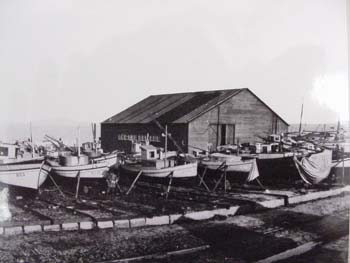
Monterey Boat Works - 1920
Did you know that a master boatwright from a family of master boatwrights lives in Salinas? In the early 1900's two brothers with their father emigrated from Sicily to the United States. In 1904, the third son, Angelo emigrated to join his brothers and father in Pittsburg, California. They worked together for a few years, but Angelo's goals differed from his two brothers. This was also a time of chaos for the world with World War I ensuing. Angelo's brothers Tom and Frank decided to Americanize the spelling of their last name. Angelo would have nothing to do with it. He wanted to keep his heritage and decided that it was time for him to move his family across the bay. The other two brothers eventually expanded their business to housing development and their boat building business became secondary.
Angelo's first boat shop was on Wave Street in Monterey. He specialized in building Lamparas. These boats were rounded stern fishing boats, between 40-50 feet long and designed for net fishing, namely for sardines, which of course at this time, was the primary fishing done in Monterey. In addition to building Lamparas, the Wave Street Boat Works also built the lighters, sometimes from the hulls of obsolete military launches. Because the Wave Street facility did not have launching facilities, a special trailer was built to haul the boats to the Monterey Boat Works which had its own rails for launching. Only a few Monterey Clippers were built by the Boat works since they were not used for sardines. Boats were built without plans. Wood templates were used instead. they bent the wood using steam.
Angelo had two sons, Raymond and Frank who themselves apprenticed under him and became master boatwrights of their own. They are better known as the master boat builders from the Monterey Boatworks from Oceanview Blvd, of Pacific Grove. Although Angelo was never allowed to purchase the land where the Monterey Boat Works was situated, it was always known as the site for the Monterey Boat Works. the Siinos purchased the Monterey Boat Works in the 1920's. Thanks to the land owners, Hopkins Marine Station of Stanford University, a marine biology research and educational facility, by keeping the large Monterey Boatworks Barn with its name maintained on the front of the barn, the Monterey Boat Works historical site and it's history along with Cannery Row and the Sardines are carefully maintained. By the way, Angelo Siino was my grandfather. We all have stories in our families. Don't wait until it's too late to journalize your family history. Start recording stories from your grandfather, grandmother, aunts, uncles, etc. It's a wonderful legacy to pass on to your children. The last Master Boatwright from the Monterey BoatWorks is my uncle, Ray Siino, who now lives with his wife, Val in Salinas.
Published in the Monterey Peninsula Hearld, Thursday, September 16, 1937
Santa Rosalia Celebration Is Planned Sunday
Annual festival of Santa Rosalia will be celebrated Sunday, September 19, by the Italian colony of Monterey under the auspices of the Italian Catholic Federation.
Sunday morning at 9:15 solemn high mass will be sung in San Carlos Church in honor of the Saint, with special music by the choir. At 2:30 p.m., there will be a procession to the municipal wharf where the Most Rev. Phillip G Scher, bishop of Monterey-Fresno diocese will bless the fishing fleet. Benediction of the Most Blessed Sacrament will close the ceremonies at 4 p.m. in San Carlos Church.
The Pittsburg I.C.F. band will lead the procession to the wharf with marching units of the local I.C.F. branch participating. From the wharf the procession will move along Del Monte Avenue and through Alvarado Street. The Pittsburg band will present a concert at Alvarado and Main Streets following the ceremony.
The annual pilgrimage and the blessing of the fishing fleet are age old customs observed in Palermo, Italy, from where almost all of the Italian people living in Monterey originally came. An annual fiesta is held in honor of Santa Rosalia, patron saint of Palermo and of all fisher folk.
Committee in charge of the local observance includes: Pete Ferrante, chairman, assisted by Frank V. Bruno, Frank Balesteri, Mary Balesteri, Mrs. Pete Ferrante, Mrs. P. Giamona, and Mrs. C. Balbo.
Published by the Monterey Peninsula Hearld, Wednesday, September 29, 1937
Along the Waterfront
By Albert Cambell
Eneas in Trouble
One hundred tons of sardines booked for delivery at San Carlos Cannery here went astray to a Richmond plant yesterday when the Eneas, purse seiner captained by Gene Enea, ran into minor trouble near San Francisco.
With a hold full of fish and 15 tons on the deck Monday night, the seiner lost her hatch cover bucking heavy seas. The deck-load was tossed overboard and the boat headed for San Francisco, unable to make Monterey with the handicap of an open hatch which poured quantities of water into the hold.
The seiner unloaded at Richmond and picked up a new hatch in San Francisco. Today she pulled into Monterey with another 100 tons of fish.
The crew reported a ticklish few minutes after the hatch parted company with the boat but "alls well that ends well."
Published by the Monterey Peninsula Hearld, Monday, September 20, 1937
Patron Saint of Fisherman Honored in Annual Rites
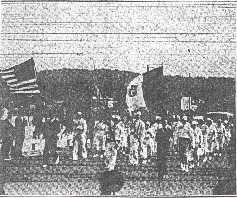


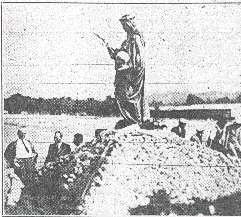
Hundreds of local Italian residents thronged Monterey's municipal pier yesterday afternoon to participate in the annual observance of the Feast of Santa Rosalia, a traditional ceremony introduced into the local community by former residents of Palermo, Italy, where most of the local Italian families originated. Upper left: San Rosalia Lodge of the Italian Catholic Federation, sponsors of the celebration, marching upon the wharf; upper right: part of the throng assembled about the platform from which Bishop Philip G. Scher pronounced his blessing upon the fishing fleet, a portion of which appears at the left alongside the wharf; lower left: Father Marzani of Sacramento, delivering an address in Italian, Bishop Scher in center, with Father William G. Batt at his left; lower right: statue of Santa Rosalia, borne upon a gaily decorated float. Father Batt and Father John F Durkin of San Carlos parish assisted Bishop Scher in the religious portion of the ceremonies.
--Hearld Photos.
Published by the Pittsburg Post Dispatch
Another Sister City Eyed for Pittsburg
Pittsburg - On the northwest coast of Sicily about 10 miles from the capital of Palermo sits the small fishing village of Isola delle Femmine.
An economic collapse in Italy about 100
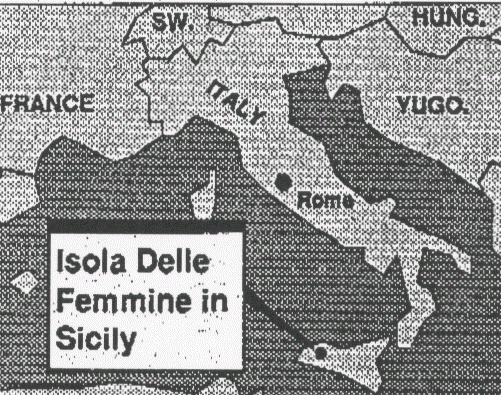 years ago sparked a migration of Italians from Isola to Pittsburg,
where they had heard the fishing was good and the climate gentle.
years ago sparked a migration of Italians from Isola to Pittsburg,
where they had heard the fishing was good and the climate gentle.
With their know-how and thirst for opportunity, the Isola settlers, as well as people from other parts of Sicily and the mainland, built Pittsburg into a bustling fishing community.
Vince DiMaggio's grandparents were among those who left Isola in the early 1900s and settled here. Now, DiMaggio would like Isola and Pittsburg to become sister cities.
"There is something unique here, something that ties the two places together," said DiMaggio, 53, who lives in Piedmont. "History has always interested me, as have my roots."
Published by The Pinnacle, Wednesday, November 27, 1991

Resident feted during visit to his native Sicily
A Hollister resident on a golden wedding anniversary trip to his native Sicily with his wife was presented a plaque from the mayor of his home town.
Mario Lucido received the plaque from Vincent DiMaggio, mayor of Isola delle Femmine, as a remembrance for a native son who had done well in the United States.
His wife, the former Katherine Russo, his niece and hostess Nancy Billeci, and Councilman Tonino Scala, were present for the honor on Oct. 14 during the two-month trip. The couple returned to Hollister last Thursday, after having left Sept. 20.
Lucido left his home, near Palermo, in 1935 at the age of 19 for the United States and met his future wife in Monterey, where he was a commercial fisherman. They married at San Carlos Church on Sept. 20, 1941, 11 weeks before the United States was catapulted into war against Japan, Germany and Italy.
However, Lucido had no doubts about his love for his adopted county and entered the US Army.
The Lucidos are the parents of Maria Scagliotti of Newcastle and Patty Wiley of Colorado Springs, Colo. They have three granddaughters. They have lived in Hollister for 37 years and are active in the Italian Catholic Federation. He retired 10 years ago.
The Lucidos have a zest for life and enjoy their bicultural background.
"It was nice to go to my original home for a long visit," Lucido said, "and it was good to return to our home in Hollister again."
Published by the Pittsburg Post Dispatch
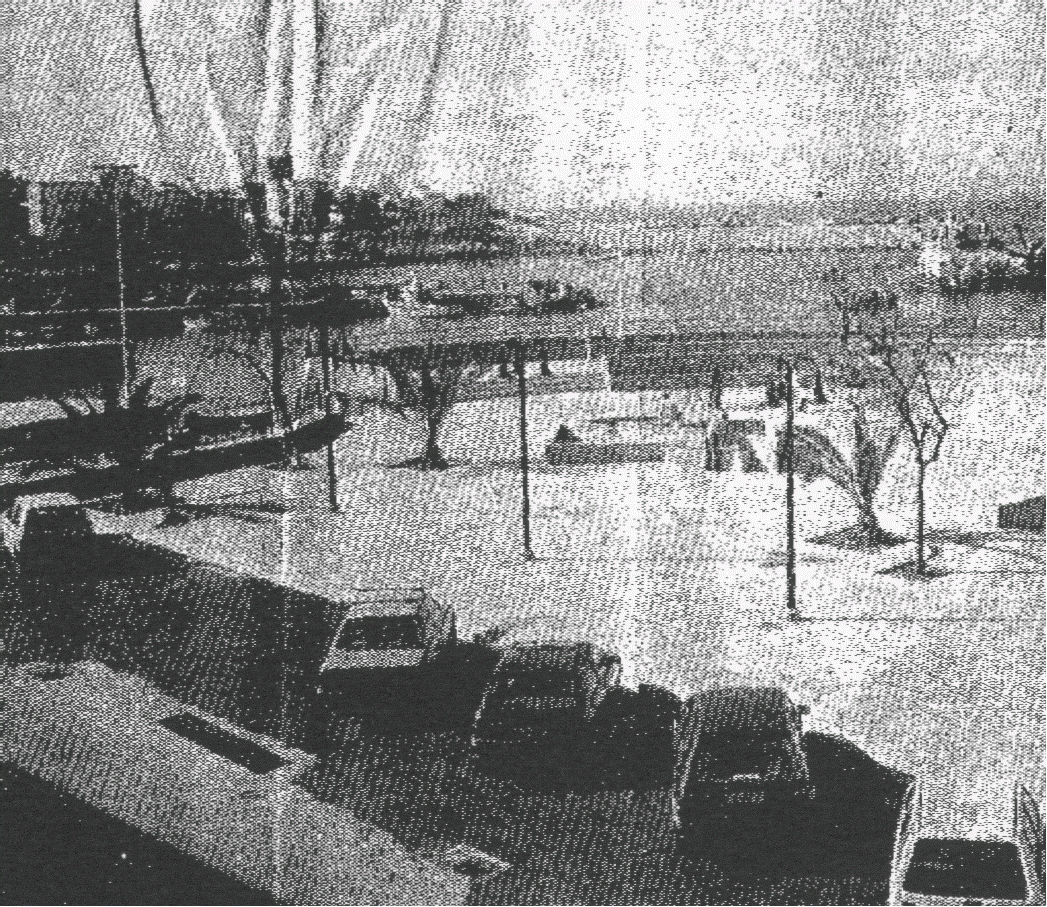
Pittsburg's Sicilian sister city names new plaza in honor of ties
Pittsburg - A new waterfront plaza in Isola delle Femmine, Sicily, has been named in honor of Pittsburg, its sister city in the United States.
The Isola delle Femmine City Council dedicated the new plaza in April, said Frank Bruno, chairman of the Pittsburg-Isola delle Femmine Sister City Committee.
A delegation from that city, including its mayor, visited Pittsburg in October 1992. That is when the idea for naming the plaza in honor of Pittsburg took off, said Vince DiMaggio, co-chairman of the committee.
Isola delle Femmine, the "Isle of Women" which attracts summer tourists to its beaches, is a small fishing village. Its sister-city pact with Pittsburg--also once a small fishing town--was approved in Novermber 1992.
It is estimated that half of Pittsburg's Italian population descended from immigrants who arrived from Isola.
Isola's new waterfront plaza, as do many in Europe, is an open space area near downtown businesses. This one is a few blocks from Isola's center, DiMaggio said.
A replica of Pittsburg's fisherman statue, now standing near the Pittsburg Marina, is also being produced for mid-1994 delivery to Piazza de Pittsburg, DiMaggio said.
Frank Vitale, the sculptor who made the original statue, is making the second as well.
DiMaggio hopes that a delegation of sister-city committee members and possibly other Pittsburg residents can make the trip to Isola in mid-1994 to present the fisherman statue.
Published by the Monterey Peninsula Hearld, Saturday, November 9, 1929
Two Fishing Boats Crash Upon Rocks During Fog
Crews Reported Saved But Damage to Equipment May be Heavy
Two Monterey fishing fleet boats went on the rocks off Santa Cruz in the thick fog that covered the bay last night.
The New Moon, owned by S. Russo, went ashore shortly after 10 p.m. The purse seiner Lorenz, Captain Sandanger, was reported ashore shortly after, further up the coast. The New Moon struck just outside the Santa Cruz city limits near Moore's Beach. The Lorenz was further up the coast near Daverport. No lives were reported lost, and the damage to Russo's boat is around $8000. The condition of the Lorenz is not known and at the time of writing she is still on the rocks, while Russo's vessel is on its way across the bay.
S. Ventimiglia went to the rescue this morning and started to tow the New Moon back across the bay, after getting her off the rocks. She has a gash in her hull and was pretty well under. The towing was slow going. T. Balesteri went with Ventimiglia and towed the lighters, three of them. The going was slow, and O. Enea's boat left shortly before noon to help pull Russo's water logged wreck across the bay. It was estimated that it would be almost dark by the time the vessels reached here.
No further reports have yet come from the Lorenz.
